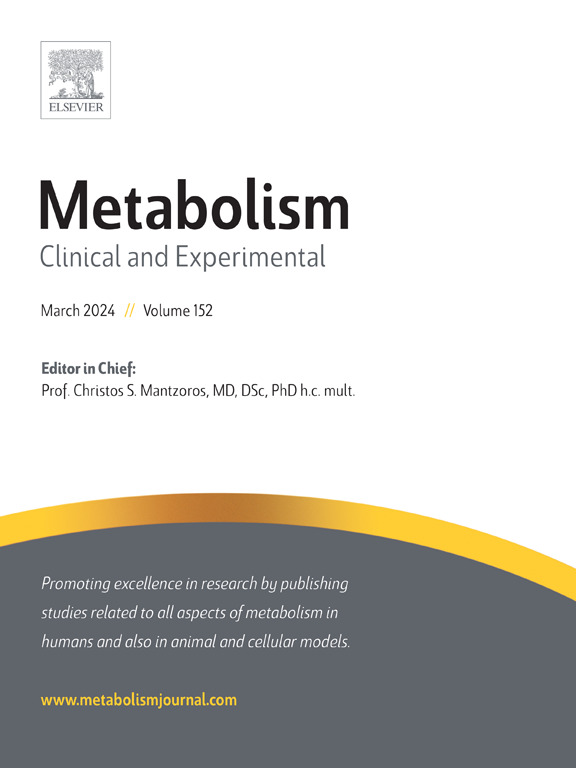Symphony of regulated cell death: Unveiling therapeutic horizons in sarcopenia
IF 11.9
1区 医学
Q1 ENDOCRINOLOGY & METABOLISM
引用次数: 0
Abstract
Sarcopenia is a progressive musculoskeletal condition associated with aging, marked by a decline in muscle mass, strength, and performance. This condition not only compromises functional independence in older individuals but also contributes to escalating healthcare and economic burdens. Although the underlying mechanisms are complex and multifaceted, recent discoveries have emphasized the regulatory influence of multiple forms of programmed cell death—including apoptosis, ferroptosis, necroptosis, and pyroptosis—on skeletal muscle degeneration. These cell death pathways contribute to key pathological features such as muscle fiber loss, proteostasis imbalance, neuromuscular dysfunction, mitochondrial deficits, and persistent inflammation. This review synthesizes current understanding of the molecular underpinnings of regulated cell death (RCD) in sarcopenia and discusses emerging therapeutic interventions aimed at modulating these pathways. These include pharmacological agents (e.g., ferroptosis inhibitors, polyphenols), structured exercise programs (notably resistance), targeted nutritional support (e.g., amino acids, vitamin D), cell-based therapies, and gene-targeted strategies. Despite growing evidence supporting RCD as a viable therapeutic target, the interplay among different cell death modalities and the translation of mechanistic insights into clinical practice remain insufficiently understood. Advancing sarcopenia treatment will require integrated multi-omics analyses, identification of predictive biomarkers, and rigorously designed clinical studies to support personalized and effective therapeutic approaches.
调控细胞死亡交响曲:揭示肌肉减少症的治疗前景
肌肉减少症是一种与衰老相关的进行性肌肉骨骼疾病,其特征是肌肉质量、力量和表现的下降。这种情况不仅会损害老年人的功能独立性,而且还会增加医疗保健和经济负担。尽管潜在的机制是复杂和多方面的,但最近的发现强调了多种形式的程序性细胞死亡(包括细胞凋亡、铁下垂、坏死下垂和热死)对骨骼肌变性的调节作用。这些细胞死亡途径导致关键的病理特征,如肌纤维损失、蛋白质平衡失衡、神经肌肉功能障碍、线粒体缺陷和持续炎症。本文综述了目前对肌肉减少症中调节细胞死亡(RCD)的分子基础的理解,并讨论了旨在调节这些途径的新兴治疗干预措施。这些包括药理学药物(例如,铁衰落抑制剂,多酚),有组织的锻炼计划(特别是抵抗),靶向营养支持(例如氨基酸,维生素D),基于细胞的治疗和基因靶向策略。尽管越来越多的证据支持RCD作为一种可行的治疗靶点,但不同细胞死亡模式之间的相互作用以及将机制见解转化为临床实践的理解仍然不够充分。推进骨骼肌减少症的治疗将需要整合多组学分析,识别预测性生物标志物,以及严格设计的临床研究,以支持个性化和有效的治疗方法。
本文章由计算机程序翻译,如有差异,请以英文原文为准。
求助全文
约1分钟内获得全文
求助全文
来源期刊

Metabolism: clinical and experimental
医学-内分泌学与代谢
CiteScore
18.90
自引率
3.10%
发文量
310
审稿时长
16 days
期刊介绍:
Metabolism upholds research excellence by disseminating high-quality original research, reviews, editorials, and commentaries covering all facets of human metabolism.
Consideration for publication in Metabolism extends to studies in humans, animal, and cellular models, with a particular emphasis on work demonstrating strong translational potential.
The journal addresses a range of topics, including:
- Energy Expenditure and Obesity
- Metabolic Syndrome, Prediabetes, and Diabetes
- Nutrition, Exercise, and the Environment
- Genetics and Genomics, Proteomics, and Metabolomics
- Carbohydrate, Lipid, and Protein Metabolism
- Endocrinology and Hypertension
- Mineral and Bone Metabolism
- Cardiovascular Diseases and Malignancies
- Inflammation in metabolism and immunometabolism
 求助内容:
求助内容: 应助结果提醒方式:
应助结果提醒方式:


